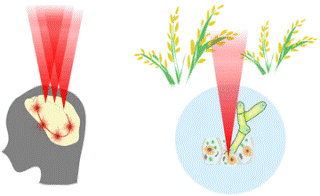Jan 29 2019
Stimulation and imaging-based functional optical microscopy, or SIFOM for short, is a novel optical microscope system that can activate numerous cells at the same time through a holographic technique method, and post the stimulation, can track cell activity using three-dimensional (3D) measurements based on fluorescence holography.
 Illustration of optical stimulation of cell activity in human brain and plant cells by holographic optogenetics. (Image credit: Kobe University)
Illustration of optical stimulation of cell activity in human brain and plant cells by holographic optogenetics. (Image credit: Kobe University)
The latest system has potential uses as a groundbreaking tool; for instance, it could be used for building artificial neural networks, rebuilding lost nerve pathways, and for the development of food resources. The SIFOM concept and the feasibility check have been reported on November 1st, 2018 in Optics Letter, one of the leading journals of the optics and photonics research field.
To date, a majority of optical microscopies like fluorescence microscopy, phase contrast microscopy, super-resolved fluorescence microscopy, and multi-photon microscopy have been designed. Now, thanks to the latest innovations in optics technology, researchers can view the cells’ ultrafine structure as well as their functions in both in vivo and in vitro. The light can now be used to control cell activity as in optogenetics with the help of channelrhodopsin or other similar proteins. Conversely, the current optogenetics-based light stimulation used for controlling cell activity is relatively simple, utilizing uniform exposure through optic fibers or by LED, and thus enabling only a low degree of cell manipulation.
An advanced optical microscope system, known as SIFOM, has been proposed in the latest study. The SIFOM includes a couple of sub-functions—3D stimulation of cells and 3D observation of cells depending on digital holography. The SIFOM is the first-ever microscope to be integrated with technology that can perform 3D observation and stimulation at the same time, and it also has promising applications as a revolutionary tool in the field of life sciences. This technology uses high-speed scanless photography and provides information regarding various events that take place in 3D space within an extremely short period of time.
The researchers utilized lung cancer cells as well as fluorescent beads with an approximate size of 10 µm, as part of their verification experiment. A fluorescent hologram in a defocused state was subsequently recorded from the focal position in the depth direction and a reconstruction of the fluorescent beads and the cancer cells was successfully achieved.
A multi-institution interdisciplinary collaborative research team performed the study. It was headed by Professor Hiroaki Wake (Kobe University, Graduate School of Medicine) and Professor Osamu Matoba (Kobe University, Graduate School of System Informatics) in association with Professor Yasuhiro Awatsuji (Kyoto Institute of Technology, Faculty of Electrical Engineering and Electronics) and Professor Yoshio Hayasaki (Utsunomiya University, Center for Optical Research and Education).
At the time of the verification experiment, the team was able to visualize light stimulation for a maximum number of five cells at a single time. Furthermore, the maximum number of activated cells is primarily established, because adequate light power is not available for stimulation.
In two-dimensional (2D) space, it is believed that light stimulation can be simultaneously done for more than 100 cells, and going forward, the researchers are planning to expand the depth of stimulation to several hundred micrometers through two-photon stimulation.
When it comes to visualizing living cells, the power of fluorescence is limited to prevent damage to the cells, and as a result, high-sensitivity measurements are needed. The researchers are aiming to resolve these problems and prepare the novel optical microscopy system for practical applications.
We have a research grant from JST CREST Grant Number JPMJCR1755, Japan to fabricate a SIFOM and then apply it to further development of neuroscience. We will collaborate with companies to introduce the new optical microscope into the commercial market.
Osamu Matoba, Professor, Graduate School of System Informatics, Kobe University.